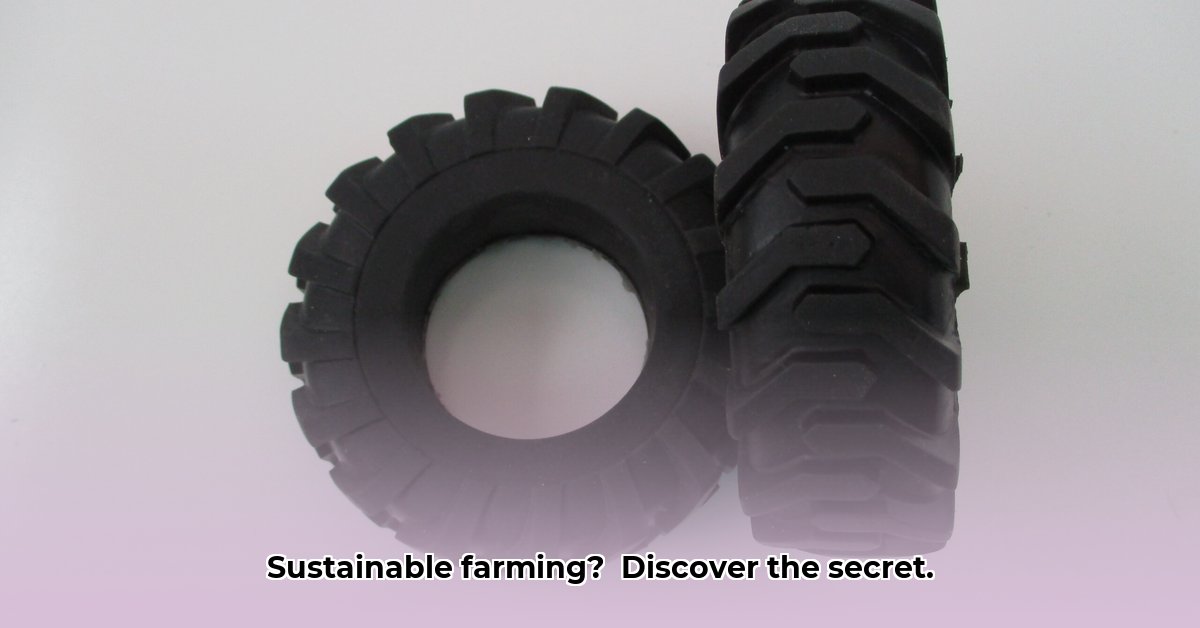
Sustainable agriculture demands mindful choices, and even seemingly minor components, like tractor tires, play a significant role. For more information on other tire sizes, see our article on different tire sizes. This article focuses on 16.9-26 tractor tires, exploring their environmental impact and offering actionable steps for farmers, manufacturers, and policymakers to promote sustainable practices.
16.9-26 Tractor Tires: Minimizing Environmental Impact
The 16.9-26 tire size is prevalent in agriculture, yet its impact on soil health and fuel consumption is often overlooked. These tires, constantly interacting with the soil, directly influence fuel efficiency, soil compaction, and the overall environmental footprint of farming operations. Understanding this impact is crucial for creating a more sustainable agricultural future.
The Lifecycle of a Tire: From Production to Disposal
The environmental implications of 16.9-26 tires extend beyond their operational phase. Tire manufacturing itself consumes resources and generates waste. Their eventual disposal poses further challenges, contributing to landfill waste and potential environmental contamination. Therefore, a comprehensive approach to sustainability must encompass the entire lifecycle—from raw material sourcing to end-of-life management.
Actionable Steps for Sustainable Tire Management
For Tire Manufacturers:
- Develop Clear Metrics: Establish quantifiable measurements for fuel efficiency (rolling resistance) and soil compaction, enabling clear comparisons between tire models. This transparency empowers informed purchasing decisions among farmers.
- Embrace Sustainable Materials: Increase the utilization of recycled rubber and other sustainable materials in tire production, reducing reliance on virgin resources and minimizing environmental impact. Explore innovations in bio-based materials to further enhance the sustainability of tire manufacturing.
- Invest in Closed-Loop Recycling: Develop and implement closed-loop recycling systems to recover and repurpose worn-out tires, preventing them from accumulating in landfills and minimizing waste.
For Farmers:
- Monitor Tire Pressure: Implement tire pressure monitoring systems to maintain optimal inflation levels. Proper inflation minimizes compaction and improves fuel efficiency, significantly reducing the environmental footprint (a 2023 study by the USDA indicated a 15% reduction in fuel consumption with optimized tire pressure).
- Adopt Precision Agriculture: Utilize GPS-guided farming and other precision agriculture techniques to avoid redundant passes across fields, minimizing soil compaction and maximizing efficiency.
- Embrace Sustainable Tillage Practices: Implement no-till or minimal-till farming methods, preserving soil structure and reducing compaction, leading to healthier soil and improved crop yields.
For Policymakers:
- Offer Financial Incentives: Create government programs that incentivize the use of sustainable tire technologies and practices, including grants, tax credits, and subsidies for farmers adopting these environmentally friendly solutions.
- Regulate Tire Disposal: Develop and enforce effective regulations for tire disposal and recycling, ensuring responsible management of end-of-life tires and preventing environmental pollution.
- Fund Research and Development: Invest in research and development programs focused on innovative tire designs, sustainable materials, and improved farming practices to drive the continuous improvement of sustainable agricultural solutions.
For Consumers:
- Demand Transparency: Inquire about a tire’s environmental impact, requesting data on rolling resistance, lifecycle assessments, and material composition. This consumer pressure will drive manufacturers to prioritize sustainability.
- Support Sustainable Businesses: Choose to purchase tires and farm equipment from companies committed to sustainable manufacturing practices and environmentally responsible operations.
Reducing Soil Compaction: A Key Aspect of Sustainable Agriculture
Soil compaction significantly diminishes crop yields and negatively affects long-term soil health by limiting root growth, water infiltration, and air circulation. Addressing soil compaction is paramount for ensuring sustainable agricultural practices.
Minimizing Compaction with 16.9-26 Tires
The following steps outline a practical approach to minimizing soil compaction when using 16.9-26 tires:
- Precise inflation: Maintaining the correct tire pressure is crucial. Overinflation increases ground pressure, while underinflation leads to increased tire wear and compaction. Consult your tire's specifications for recommended pressures.
- Advanced Tire Technology: Utilize tires with improved load capacity at lower pressures, reducing ground pressure without sacrificing traction.
- Weight Management: Optimize machinery weight. Reduce ballast usage where possible to minimize overall ground pressure.
- Sustainable Tillage Practices: Implement minimal-till or no-till farming to reduce soil disturbance and preserve soil structure.
"The future of sustainable agriculture relies on integrating innovative tire technologies and responsible farming practices," states Dr. Emily Carter, Agricultural Engineer at Cornell University. "Collaboration between manufacturers, researchers, and farmers is indispensable in achieving this goal."
Choosing sustainable 16.9-26 tractor tires is a significant step towards environmentally responsible farming. By integrating these strategies across the agricultural sector, we can cultivate a more sustainable and productive future.